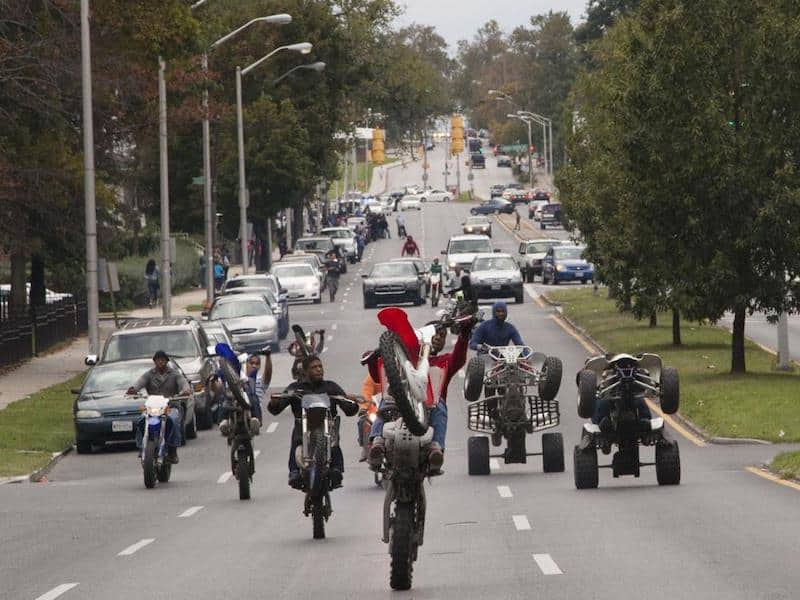
Lotfy Nathan’s rousing debut documentary, 12 O’Clock Boys, opens with a bit of unsettling shock-jock radio grandstanding. Before we even see the proud and perhaps reckless dirt bike riders that parade through Baltimore’s streets, we hear the vicious voice of their opponents. “I don’t care if one of them dies,” a local radio personality opines. As a statement, this is the worst kind of attention-grabbing talk radio nonsense. As the opening gambit of a documentary, it’s like the starting shot of a high stakes horse race, with the soul of an American city as the finish line.
That said, the film very quickly turns from this first salvo of vitriol to a much quieter, humbler kind of storytelling. The main character of 12 O’Clock Boys is Pug, a thirteen year old kid growing up on the East side of Baltimore. He lives with his mother, Coco, and his three siblings. More than anything else in the world he wants to become one of the “12 O’Clock Boys,” the city’s famous gang of dirt bike riders – so named because they pop wheelies so high their bikes strike Noon.
The appeal is pretty understandable. These bikers get their cool, in part, from their sheer physical presence. They don’t really have the aesthetic intimidation of a traditional biker gang, but they more than make up for it with their impressive, often reckless maneuvers. This puts them in trouble with the law, which only adds to their appeal in Baltimore neighborhoods where there may already be resentment of the police. The cops can’t actually chase them, because to do so would further endanger innocent bystanders. Instead, the BPD uses helicopters to track the bikers, which inevitably publicizes every pursuit. When you add in the Internet factor, bikers uploading videos of their exploits to YouTube, it’s hard to imagine a more notorious sort of local celebrity.
Nathan comments on this by refusing to present this bikers as criminals, at least not without a great deal of nuance. Slowed down and matched to a soundtrack that embraces their cool, the wild rides of 12 O’Clock Boys get to the heart and soul of this rebellious band of outlaws. This is about freedom, of course, the ability to travel out into the city with speed and style. But it’s also about power, the display of skill that everyone notices, not only because it is loud and perilous but because it’s attractive.
Nathan’s film is a spiritual heir to Tony Silver’s 1983 classic graffiti documentary, Style Wars. Back in the late 1970s, New York City youth from out in the poorer, neglected parts of the Outer Boroughs began tagging subway cars in part because their art would then travel to every other neighborhood in the city, wealthy enclaves and commuter-filled business districts. Their art, usually built from their own names, was a very direct form of self-expression in an urban public space. The same can be said of the bikers of Baltimore, and Nathan does them the honor of taking this brusque form of expression and presenting it to his audience as an art of its own.
Of course, it’s important to remember that not every day is a joy ride. 12 O’Clock Boys is also a portrait of a family. Coco is raising Pug and his siblings without their father, in a community that is dangerous for reasons that have nothing to do with bike accidents. The constant struggle to keep Pug home and away from trouble is maybe the central conflict of the film, to the extent that it has one. These family sequences never quite develop into a narrative, instead becoming softer tonal material. They work as a beautiful contrast to the stylized sequences of the bikers on the road, but the two modes often sit parallel rather than build upon each other.
At the end of the day, this is a movie about dirt biking. Pug is a wonderful central character, in many ways as charismatic as his heroes. Yet there is also a sense that something more is going on in the community and the city itself, which only crop up in the single diversion into the story of a former cop that may have caused a terrible accident in pursuit of a biker. The difference between 12 O’Clock Boys and Style Wars is perhaps their sense of space and context, the latter taking a much broader look at how these graffiti artists factored into the life of New York City as a whole. 12 O’Clock Boys is a biking movie first and a Baltimore movie second. It brushes with greatness, but might be just a smidge too enamored of its own heroes to get there.
The Upside: The sequences of the dirt bike rides are thrilling, managing to capture the spirit of this high-speed phenomenon in slow motion.
The Downside: While the action is strong and the family drama is compelling, a real understanding of how these bikers fit into the larger community of Baltimore seems just out of reach.
On the Side: According to this New York Times interview, Nathan actually received court summonses for “filming illegal activity” during production.
Related Topics: Documentary
